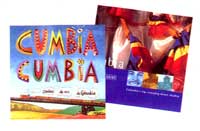Near the end of the 17th century in the Caribbean coastal towns of Colombia, slave
owners gave their human property – men from Africa, as well as the men and women the conquistadors
had taken from local Amerindian tribes – permission to play music and dance
 on certain holidays. On those days, they danced the cumbia.
on certain holidays. On those days, they danced the cumbia.
The cumbia gets its name from the cumbè, a dance that originated in Guinea. In the
colombian version, men and women came to the event dressed entirely in white – the women wore
long, multi-layered skirts and the men carried bundles of candles or torches, which were lit
and held as they gathered in a circle.
On at a time, couples moved to the center to dance their flirtation. The women would lift her skirt,
simultaneously pushing the man away and enticing him closer. The dance evolved against rhythms
surrounding them, the men attempting to win over the women with his dancing and by ritually passing
her fire from his bouquet of candles.
African percussion and rhythms, Spanish structure and Amerindian melodies and melancholy all combine
to create cumbia. Many ethnomusicologists consider it the Queen of the Latin Rhythms – the mother of
son, salsa, merengue and other Latin music. Listening to the underlying beats, on can hear in cumbia’s
shuffles and breaks the lilts and jumps of many other Caribbean-Latin styles. This hybrid music, created
to provide the setting for flirtation and celebration, may mark the first true tricultural amalgam of music.
The confluence of traditional instruments also produced an unusual fusion. Although the cumbia began with
African drums and voice, soon native wind instruments, such as the gaita (a flute with a sharp tone),
cane flutes and Spanish instruments, such as guitars and ouds ( a type of lute), entered the arrangements.
Through the years, cumbia has continued to develop, adding caja drums, scrapers and frequently squeezeboxes
along side trombones, clarinets, saxophones, trumpets and synthesizers.
The look of cumbia has changed, too, as the clothing has become brighter and the dance is frequently performed
by troupes of women.
Cumbia has evolved into one of Colombia’s cultural treasures. Although other musical forms have sprung up, the
cumbias from the Caribbean are danced and performed throughout the country – and not just on holidays. Two
anthems, "La Pollera Colora" and "La Cumbia Cienaguera," are as ingrained into the culture
and history of Colombia as "This Land is My Land" is to the United States.
 on certain holidays. On those days, they danced the cumbia.
on certain holidays. On those days, they danced the cumbia.